
Construction sites are often bustling environments with multiple contractors, subcontractors, and workers all performing different tasks at the same time. This coordination increases productivity, but it also raises the risk of accidents. When a construction accident occurs on a multi-contractor site, determining liability can be challenging.
Construction accidents on multi-contractor sites are often complicated and require thorough investigation. Determining liability is essential to recover damages and achieve a fair outcome. At the Law Office of Jack M. Shapiro, P.C., I’ve represented clients who suffered serious injuries in accidents involving multiple responsible parties.
Located in Buffalo Grove, Illinois, I serve clients statewide. Reach out today for assistance from an experienced IL personal injury attorney.
Common Causes of Construction Accidents
Construction accidents can happen for a variety of reasons, often stemming from unsafe work practices or poor coordination between contractors. Some of the frequent causes I see include:
Unsafe scaffolding or ladders
Failure to follow proper safety procedures
Faulty equipment or machinery
Falling debris or materials
Electrical hazards or exposed wiring
Lack of protective gear or safety signage
In many cases, multiple contractors contribute to these hazards. For example, one subcontractor might leave equipment in an unsafe location while another is operating heavy machinery nearby.
This overlap of responsibility makes it critical to identify all parties involved. Construction accidents can range from minor injuries to life-threatening events. The severity often influences how liability is assigned and how claims are handled.
General Contractors
General contractors usually oversee the entire construction project. They coordinate schedules, manage subcontractors, and monitor safety procedures. When an accident occurs, the general contractor may bear some responsibility if they failed to maintain safe working conditions.
Common factors that may establish liability for a general contractor include:
Failing to monitor subcontractor compliance with safety rules
Not providing proper training or safety instructions
Ignoring hazardous conditions reported on-site
Allowing overcrowding or unregulated work areas
While general contractors don’t perform every task themselves, they’re responsible for organizing operations in a way that protects workers. In my experience, a clear understanding of a general contractor’s duties is often a key factor in construction accident claims.
Subcontractor Responsibilities
Subcontractors perform specific portions of a project, such as electrical work, plumbing, or concrete pouring. Their employees are expected to follow safety standards and carry out their tasks correctly. A subcontractor may be liable for construction accidents if:
Employees act negligently or recklessly
Equipment is improperly maintained or used
Safety protocols are ignored
Work creates hazards for others on the site
Because multiple subcontractors often work simultaneously, liability may be shared when one contractor’s actions directly impact another’s work area. I frequently see cases where a subcontractor’s oversight contributes to another worker’s injury.
Equipment Manufacturers and Suppliers
Construction sites rely on a wide range of equipment, from cranes to power tools. When a piece of machinery malfunctions, it can lead to serious injuries. Manufacturers or suppliers may be liable if:
Equipment is defectively designed or built
Safety warnings are missing or inadequate
Proper maintenance instructions aren’t provided
Identifying defective equipment as a cause of construction accidents requires careful examination. In many cases, liability may extend beyond the contractors to include manufacturers who failed to design or label equipment safely.
Property Owners and Project Managers
Property owners and project managers can also share liability, especially if they control site conditions or hire contractors. Their responsibilities may include:
Providing a safe working environment
Addressing known hazards on the property
Verifying that contractors follow safety regulations
In some cases, I’ve seen property owners held accountable when hazardous conditions, like unstable flooring or exposed wiring, were ignored despite repeated warnings. Recognizing the role of property owners can significantly impact a construction accident claim.
Common Scenarios in Multi-Contractor Accidents
Construction accidents often involve multiple parties, making liability more difficult to determine. Some typical scenarios include:
Scaffold collapse: One subcontractor installs a scaffold incorrectly, while another worker is using it for painting. Both parties may share liability.
Equipment collision: A crane operated by one contractor strikes a worker from another subcontractor. Equipment operator, subcontractor, and general contractor may all be involved.
Falls from height: Safety harnesses are provided but not used, and debris left by one contractor contributes to a fall. Shared responsibility may apply.
These scenarios demonstrate why construction accident claims often require a thorough investigation to determine which parties contributed to the injury.
Evidence That Supports Liability
Proving who is liable in construction accidents relies on solid evidence. When I work with clients, I prioritize collecting documentation and testimony that accurately represents the scene. Important evidence often includes:
Accident reports and OSHA records
Witness statements from coworkers or supervisors
Photos or videos of the site at the time of the accident
Maintenance logs for equipment and machinery
Contracts outlining the roles and responsibilities of contractors
Medical reports showing the extent of injuries
This evidence helps assign responsibility accurately, whether it involves a general contractor, subcontractor, or equipment manufacturer. Proper documentation is essential in supporting claims for damages after construction accidents.
Shared Liability and Comparative Negligence
Construction accidents frequently involve shared liability. In Illinois, the law allows for comparative negligence, which means that compensation may be reduced if the injured party is partially responsible. For example:
A worker might be partially at fault for not wearing protective gear
Contractors may share liability if multiple safety violations contributed to the accident
Equipment failure combined with human error may lead to divided responsibility
Understanding how comparative negligence applies can affect settlement negotiations and trial outcomes. I often analyze the behavior of each party to determine the degree of responsibility for construction accidents.
Injuries Commonly Sustained in Construction Accidents
Construction accidents can cause serious injuries, often requiring extensive medical treatment. Common injuries include:
Fractures and broken bones
Head injuries, including concussions and traumatic brain injury
Spinal cord injuries leading to partial or total paralysis
Lacerations and deep cuts
Burns from chemicals or electrical sources
Musculoskeletal injuries from heavy lifting or falls
These injuries often have long-term impacts on a worker’s life. Recovery can be slow, expensive, and may limit future employment. This is why filing a claim for damages is so important after construction accidents.
Financial and Legal Consequences
The costs of construction accidents extend beyond medical bills. Victims may face lost wages, rehabilitation expenses, and ongoing care needs. Legal claims can address:
Medical expenses, current and future
Lost income and loss of earning capacity
Pain and suffering
Emotional distress caused by the accident
Property damage if personal belongings were affected
When multiple contractors are involved, distributing liability fairly makes sure that victims receive compensation proportional to each party’s contribution to the accident.
Steps to Take After a Construction Accident
If you experience a construction accident on a multi-contractor site, taking the right steps immediately can protect your claim:
Report the accident to supervisors and document the incident
Seek medical attention promptly
Take photographs or videos of the accident scene
Collect witness information
Avoid giving statements to insurance adjusters without legal guidance
Consult an attorney familiar with construction accidents
These steps help preserve critical evidence and strengthen claims against all liable parties.
Why It’s Important to Identify All Liable Parties
Construction accidents rarely result from a single mistake. Multiple contractors, subcontractors, property owners, and equipment manufacturers often contribute. Identifying each party responsible allows victims to pursue compensation.
When I work on these cases, I prioritize analyzing contracts, work logs, and accident reports to trace liability. Doing so helps clients recover damages for medical costs, lost wages, and other expenses related to construction accidents.
Call the Law Office of Jack M. Shapiro, P.C. Today
Construction accidents on multi-contractor sites often involve multiple parties, from contractors to equipment suppliers. Determining liability is vital for compensation and requires careful investigation of every role and safety measure. Identifying all responsible parties helps build a strong case and protects your rights.
If you or a loved one has been injured in a construction accident, the Law Office of Jack M. Shapiro, P.C. is here to help. I serve Buffalo Grove, Illinois, as well as Arlington Heights, DuPage County, Lake County, Mount Prospect, Palatine, Vernon Hills, Mundelein, Cook County, Hoffman Estates, McHenry County, Northbrook, Schaumburg, and Wheeling. Reach out today for skilled legal assistance.



